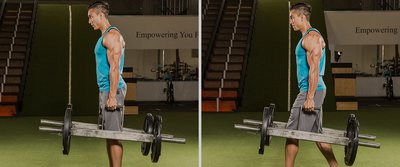Whether you refer to it as a "death circuit," "metcon," or my preference, a "finisher," the goal is one and the same. You spend 10-15 minutes at the end of your training session kicking the living crap out of yourself. You push things, lift things, throw things, pull things, flip things, and more or less hate life until you finally stagger to the showers.
A finisher does more than finish your workout. It finishes you.
On one hand, I get it. There's a sense of accomplishment that comes with completing a challenging finisher, and I for one will never begrudge someone going out of his or her way to work hard and get after it in the gym.
On the flip side, however, I find there's a point of diminishing return where, from a recovery and injury-prevention perspective, many popular finishers can leave you exposed and vulnerable in a bad way.
As a coach, I want a finisher to do more than just finish you. Ideally, I want it to help address movement deficiencies, postural imbalances, and actually prevent injuries. It should also be really hard to screw up when you're exhausted, and give you that sweet, sweet punishment you crave.
Amazingly, such a movement does exist. It's the farmer's carry!
Farmer's Carries The Perfect Finisher?
I love farmer's carries. I feel they're one of the most underrated and least utilized exercises out there, and nearly anyone can benefit from them.
They're superb for building full-body strength. The upper and lower body both have to work—and work together— to get that weight from point A to point B.
Carries have a profound effect on grip strength by activating the rotator cuff via a process called irradiation. In non-geek speak, this means that when you squeeze something with a death grip (I like to tell people to pretend they're trying to melt the handle in their hand), the rotator cuff turns on, and as a result, the shoulder "packs" itself into a strong, stable position. In many ways, farmer's carries are an excellent choice for those working around chronic shoulder issues.

Farmer's carry
They're at the top of the list for training and improving core function. Whether performed one side at a time or while holding a weight in each hand, farmer's carries undoubtedly challenge and train the core like few other exercises can.
Carries are an underrated conditioning tool. The next time someone asks you whether or not weight training has any cardiovascular benefit, have him or her perform a few rounds of carries for 50-100 yards with limited rest. And then laugh at them.
They're surprisingly effective when the goal is to build upper-back mass. Your entire back must fire isometrically to stay upright throughout the duration of the set.
Carries are a self-limiting exercise. This means that pretty much anyone, regardless of sex, age, or ability level, can perform them in some fashion with little risk of injury, due to the low learning curve involved.
This last point is key, because, while I respect anyone who can perform and complete a finisher incorporating high-rep clean and presses, deadlifts, or any similar, highly technical movement, I wouldn't dream of having most clients subject themselves to that gauntlet.
A Quick Primer on Proper Carry Technique
While the premise is pretty straightforward—you pick up a pair of heavy dumbbells, kettlebells, or carry attachments and, you know, carry them—there are a few things to consider when it comes to technique.
First and foremost, heavier isn't always better. This is the most common problem I see. If you find you're leaning forward or to any side, or you feel like you're close to dislocating due to the weight you're carrying, stop it. Stop it right now. Put the weight down, and pick up something lighter.
I also have a few more specific anatomical cues that I lay out in this video.
3 Farmer's-Carry Finishers
Option 1: Carry for Distance
There's no smoke and mirrors with this finisher. Grab a pair of dumbbells or kettlebells and carry them for a specific distance. You can progress by using a heavier load, increasing the distance, or both.
For example:
- Week 1: Do 3-4 rounds with the heaviest weight you can safely handle for 20-25 yards. Maximum total distance of 100 yards.
- Week 2: Do 4-6 rounds with the heaviest weight you can safely handle for 20-25 yards. Maximum total distance of 150 yards.
- Week 3: Do 7-10 rounds with the heaviest weight you can safely handle for 20-25 yards. Maximum total distance of 200 yards.
- Week 4: Do 12 rounds with the heaviest weight you can safely handle for 20-25 yards. Maximum total distance of 250 yards.
If that sounds like a lot of rounds, consider performing the circuit one side at a time. The offset loading places a more demanding challenge on the core because you have to fight that much harder to stay upright.
Plus, because you're performing the distance per side, you're walking twice the distance, which equates to more work.
Option 2: The Carry Step-up
Understandably for those who train in crowded commercial gyms, performing farmer's carries for distance can be problematic. One tip I stole from strength coach Ben Bruno is to perform low-box step-ups for time or a specific repetition count.
The key is to keep the box truly low, like 10-12 inches max. These require little space to perform, and they emulate farmer's carries very well.
Option 3: Farmer's Carry Inverted Ladder
Another option is to pair farmer's carries with other self-limiting exercises. No high-rep snatches here! It may look something like this:

BodyFit
$6.99/month- 2,500+ expert-created single workouts
- 3,500+ how-to exercise videos
- Detailed workout instruction
- Step-by-step workout tips
- Training at gym or at home
- Access to Workout Plans
- Access to Bodyfit App
- Store Discounts
Already have a Bodybuilding.com account with BodyFit? Sign In

What comes with BodyFit?

- Instructional Videos
Don't risk doing a workout improperly! Avoid injury and keep your form in check with in-depth instructional videos.

- How-to Images
View our enormous library of workout photos and see exactly how each exercise should be done before you give it a shot.

- Step-by-Step Instructions
Quickly read through our step-by-step directions to ensure you're doing each workout correctly the first time, every time.
Keep going until you perform one goblet squat and 10 push-ups at the end, and you will be finished. Record your time, and try to beat it the next week.
And yes—I see your hand there—you can use any number of exercise combinations like this. Others to consider would be:
- Kettlebell swings
- Medicine-ball slams
- Other push-up variations
- Front or back squats
- Bent-over rows
- Reverse crunches
- Roll-out variations
- Lunge variations
My only caveat: Be leery of adding anything that will challenge your grip too much. The farmer's carries will give you all you can handle there. For example, it may be a good idea to perform lunge variations in goblet fashion to help reduce grip fatigue.
With these guidelines in place, go carry some heavy crap until you feel like you need to be carried out!




